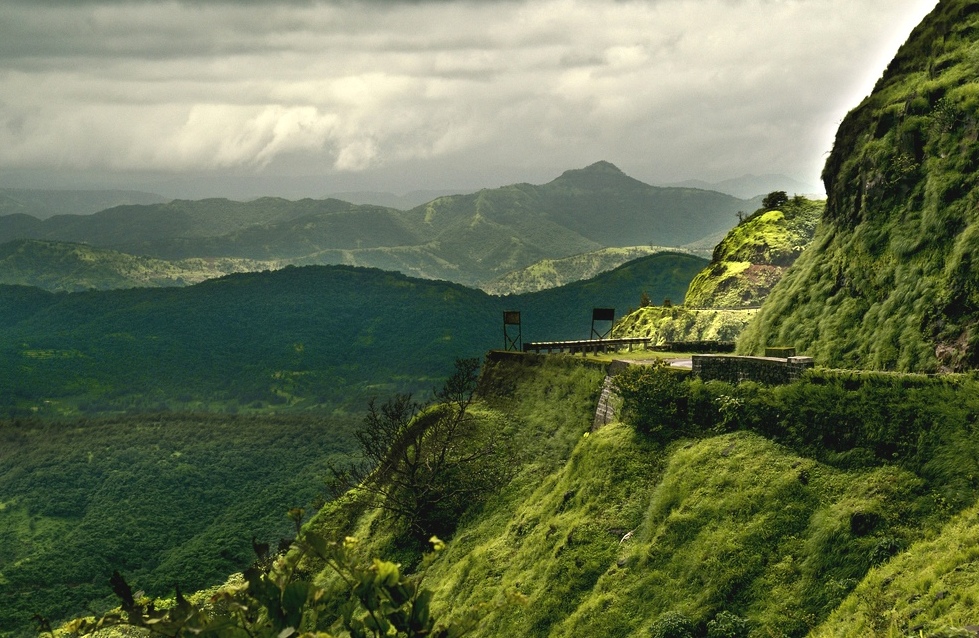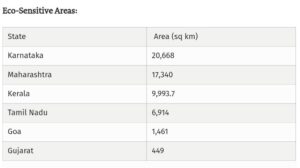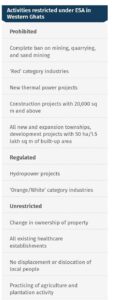Western Ghats
Western Ghats

The draft notification of ESA in Western Ghats and Karnataka’s stiff resistance to it
The Kasturirangan Committee was tasked with suggesting a holistic approach for sustainable and equitable development and conservation of ecology in the Western Ghats.
Reason for State government resistance
- On July 6 2022, the Ministry of Environment, Forests and Climate Change (MoEF&CC) reissued the draft notification of the Ecologically Sensitive Areas (ESA) in the Western Ghats.
- The Dr Kasturirangan Committee report had proposed that 37% of the total area of Western Ghats be declared ESA.
- However, legislators and ministers from Karnataka’s Western Ghats area, cutting across party affiliations, took exception to the draft notification, calling it “unscientific” and arguing that it would adversely affect the livelihood of people in the region.
- The delegation led by Chief Minister Basavaraj Bommai met Union Minister Bhupender Yadav to apprise him of the issues with the report.
- The Centre has now informed the Karnataka delegation that a high-level committee, constituted by the MoEF&CC will research the landscape, and the draft notification will not be operationalised until this panel submits its report.
Ecologically Sensitive Areas
- As per the National Wildlife Action Plan (2002-2016), Eco-Sensitive Areas (ESAs) are regions located within 10 km of protected areas such as national parks and wildlife sanctuaries. ESAs are notified and regulated by the MoEFCC under the Environment Protection Act, 1986.
- The purpose of declaring ESAs is to create “shock absorbers” to prevent ecological damage caused by developmental activities in such areas and protect them by minimising the negative impact on the ecosystem.
- They also act as a transition zone from areas that require high protection to those that need lesser protection.
- As a general principle, the width of the ESA could go up to 10 km around the protected area. However, if these sensitive and ecologically important corridors span beyond 10 km, then the width of the ESA and type of regulation may vary from area to area.
- The eco-sensitive areas demarcated under the Centre’s draft notification include protected areas and World Heritage Sites.
Process from decades
- In March 2010, the Western Ghats Ecology Expert Panel (WGEEP) was set up with ecologist Madhav Gadgil as its head. The panel submitted its report in 2011.
- In August 2012, the MoEF constituted a high-level working group (HLWG) under the chairmanship of K. Kasturirangan. The HLWG submitted its report in 2013.
- Since then, the MoEF has issued draft notifications five times — in 2014, 2015, 2017, 2018 and 2022 — inviting objections. But whenever the issue is raked up, farmers have staged protests and registered their opposition by even boycotting local panchayat elections.
- The state governments, meanwhile, have opposed both the Madhav Gadgil report as well as the ‘diluted’ Kasturirangan report, calling them “unscientific”.
Recommendations of the Kasturirangan Committee
- The HLWG was tasked with suggesting an all-round and holistic approach for sustainable and equitable development while focusing on the conservation of ecological systems in Western Ghats, a biological hotspot.
- Accordingly, the Kasturirangan report in 2013 identified an area of 59,940 sq. km of natural landscape of Western Ghats, spread across six states — Karnataka, Gujarat, Goa, Tamil Nadu, Kerala and Maharashtra— as ecologically sensitive.
- The area represented a continuous band of natural vegetation extending over a horizontal distance of 1,500 km, including protected areas and World Heritage Sites.
- The HLWG recommended prohibition or regulation of development projects and activities in the ESA which would have maximum interventionist and destructive impact on ecosystems.
In December 2021, the Ministry sought suggestions from the concerned State Governments on modifications to the boundary of the ESAs identified by the HLWG, in response to which Kerala undertook the exercise of demarcating ESAs by physical verification. The ESA recommended by the Kerala government was spread over an area of 9,993.7 sq.km, in contrast to the 13,108 sq km recommended by the Kasturirangan panel report.
Features of new draft notification

- As per the latest draft released this month, the Centre has notified an area of 56,825 sq km spread across Gujarat, Maharashtra, Goa, Karnataka, Kerala and Tamil Nadu, classifying 37% of Western Ghats region under ESA.
- However, in delineating the boundary and description of ESAs through state-wise maps and list of villages, it has excluded Kerala.
- Of the total area identified, the draft specifies 20,668 sq. km in Karnataka alone, spanning 1,572 villages across 10 districts, as covered by ESA regulations.
- But the notification itself introduces a footnote which states the ‘’actual area will be finalised based on the recommendations of the State, views of stakeholders and ESZ expert committee’’.
- The Ministry also stated that the provisions of the notification will not affect the ownership of property in the ESA and is also subject to the final orders of the court in pending litigation.
Activities which are prohibited or regulated
- The draft notification declares a complete ban on mining, quarrying and sand mining in the ESA. The existing mines would be phased out within five years from the date of issue of final notification.
- No new thermal power projects or expansion of the existing plants, and red category industries shall be allowed within the ESA. Construction projects with 20,000 sq m and above as well as all new and expansion townships, development projects with 50 ha/1.5 lakh sq m of built-up area are prohibited.
- Hydropower projects and ‘orange/white’ category industries will be allowed only after ensuring strict compliance with environmental regulations on the basis of the Environmental Impact Assessment notification.
Activities which are not restricted

- The draft notification mentions no restrictions on repair or extension or renovation of existing residential houses in the ESAs.
- All existing healthcare establishments can continue in ESA and proposed Primary Health Centres can be established. There will also be no restriction on change in ownership of property.
The implementation and monitoring mechanism
- A Decision Support and Monitoring Centre for Western Ghats will be established by the Environment Ministry in collaboration with the six State governments, as per the draft notification.
- This centre will assess and report on the status of ecology of Western Ghats on a regular basis and provide decision support facility in the implementation of the provisions of this notification.
- The post-clearance monitoring of projects and activities allowed in the ESA will be carried out by the state governments, State Pollution Control Board and the Regional Office of the Ministry.
- The concerned State Governments have to prepare an annual ‘State of Health Report’ of Western Ghats region falling within their jurisdiction to detail the steps taken in monitoring and enforcing the provisions of the notification.
Reasons why the Karnataka govt is opposing the notification
- Despite the Centre issuing multiple draft notifications since 2014 to finalise the ESA boundaries, the Karnataka government never took up a physical survey, choosing instead to remain steadfast in its rejection of the report.
- While the state government is not opposed to the demarcation of red zone that prohibits establishment of industries, it believes the implementation of the draft notification will adversely impact local residents and their livelihood, and will “hinder” development activities in the region.
- The state government has alleged that no scientific survey was undertaken to arrive at the quantum of ESA in the Western Ghats before issuing the draft notification.
- The ESAs, it says, have been declared based on satellite images of the area, without any inkling of the ground reality. The Kasturirangan report has not sought the opinion of the people and has not distributed cultural and natural landscape properly.
Views of common people and farmers
- It is being argued that declaration of the ESA in Western Ghat will lead to relocation of thousands of villagers living in the region. People in Dakshina Kannada, Udupi and Chikkamagaluru districts have been opposing the eviction of the families settled in the region.
- However, there seems to be no basis for such apprehensions since the report categorically mentions that people will not be displaced.
- A majority of planters and farmers in villages of Hassan, Chikkamagaluru and Shivamogga districts — who believe it is they who have not only conserved the Western Ghats but also widened the green cover over the years — are also unhappy that the Centre decided to consider all green patches as sensitive area merely based on an aerial survey.
- They say if the ESA is implemented, it will affect work on their individual tracts of land and estates, while also affecting those who have applied for grant of land for cultivation and residential purposes.
Stand of environmentalists
- Environmentalists have railed against the State government’s opposition and lack of a strong political will to finalise the ESA in Western Ghats, saying it will only prove disastrous for the biodiversity of a region already ravaged by unregulated development and anthropogenic pressure.
- Elected representatives have also been accused of safeguarding their vested interests in the region by misleading people under the pretext of protecting their rights. They have been stoking fears through misinformation, that people living in the Western Ghats region will lose their land and livelihood or be subjected to untold restrictions.
- Many argue, that the ESA is being opposed as it will cut off the income politicians accrue through so-called infrastructure works like railways, roads, resorts, tourism development etc. Among those opposing the report, some have huge land holdings in ESAs, some have quarries or resorts, while others have huge investments.
- Environment activists say that a report proposed for the good of the people is being rejected on the false grounds that it is “anti-people”. Against 33% of forest cover, the State has less than 20% at present and it is imperative to save Western Ghats, which is also the source of all our rivers.
-
Furthermore, the ravages of flood, landslips and the recent spate of low-intensity tremors in the coastal and Malnad regions of the State should serve as a warning of the negative fallout of environmental destruction and a daily reminder of the inescapable climate crisis.

